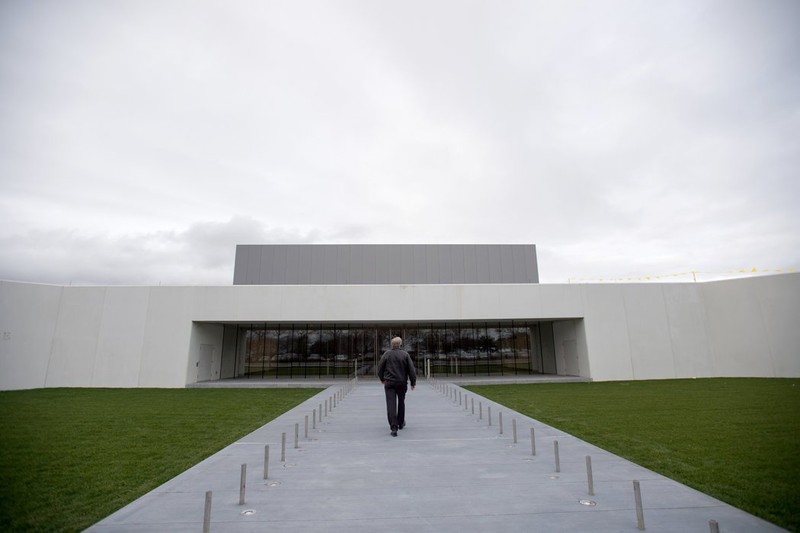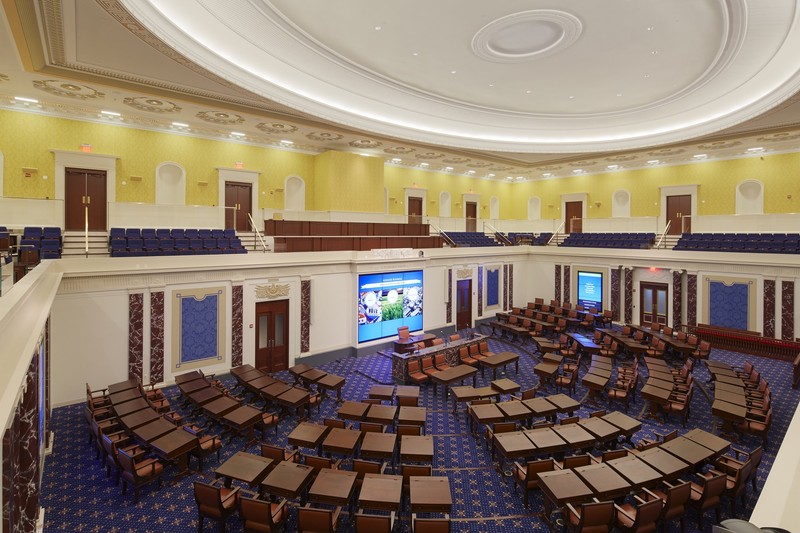Edward M. Kennedy Institute for the United States Senate
Introduction
Text-to-speech Audio
Images
Outside of the Edward M. Kennedy Institute for the United States Senate Source: Gretchen Ertl for the New York Times

Full-scale Senate Chamber Replica inside the Institute Source: Edward M. Kennedy Institute for the United States Senate

Replica of Senator Kennedy's Washington D.C. Office Source: Edward M. Kennedy Institute for the United States Senate

Backstory and Context
Text-to-speech Audio
The plan for constructing the Edward M. Kennedy Institute for the United States Senate began after Kennedy’s death in 2009. The Massachusetts senator, commonly known as Ted Kennedy, served in the Senate as a member of the Democratic Party from 1962 until his death. As a public servant for almost five decades, Kennedy championed policies such as immigration, healthcare, civil rights and education. During his time in the senate he authored over 2,500 bills and, among other positions, stood as Senate Majority Whip and Judiciary Committee Chair (senate.gov).
Shortly after Kennedy’s death, President Obama acknowledged Kennedy as someone who “loved the history and vibrancy of a uniquely American institution and was absolutely determined to keep it alive in our time” and added “there is no greater tribute we could offer him than to make the Edward M. Kennedy Institute for the United States Senate a reality” (Obama). After this official announcement on October 14, 2009, the construction of the Edward M. Kennedy Institute for the United States Senate began. On May 7, 2014 it was announced that the Institute would official open its doors in March of 2015 (PRNewswire). The location for the Institute would be on Columbia Point in the Dorchester neighborhood of Boston, next to the John F. Kennedy Presidential Library and close to the University of Massachusetts – Boston campus. The 65,000 square-foot facility designed by architect Rafael Vinoly would offer a close look at the political life of Senator Kennedy and the work of the United States Senate.
One of the major features of the Kennedy Institute is a full-scale replica of the United States Senate chamber. In the announcement of the Institute’s opening, Kennedy's widow Victoria Reggie Kennedy, co-founder and president of the board of the institute, said that it would “offer a real time perspective on how the government works” and “by shining a light on our past, it will help illuminate the path forward for addressing challenges we face today and in the future” (qtd. PRNewswire). Beginning with its introduction in 2009, representatives of the Kennedy Institute told the public that goal of the Institute was not only to honor Senator Kennedy, but also the United States Senate as an catalyst for change and progress. The Institute currently stands as the only location to have a full-scale replica of the Senate Chamber.
The mission of the Institute, as announced with its opening in 2015, is for “educating the public about the important role of the Senate in our government, encouraging participatory democracy, invigorating civil discourse, and inspiring the next generation of citizens and leaders to engage in the civic life of their communities” (PRNewswire). The Senate chamber is not only utilized for historical purposes but also to engage the public in policymaking through the Senate Immersion Module. Visiting groups, most commonly students, are given the profile of a sitting senator and are challenged with debating a policy issue Kennedy was passionate about. A staff member at the Institute then leads the process of amending and finalizing the proposed bill, and finally, the bill comes to a vote on the Senate floor (Chakrabarti). Known for playing a strong, assertive role in the Senate, Kennedy often took forceful initiative to pass bills during his time as a senator, crossing party lines and working with important leaders in Congress (Clymer).
Along with the Senate chamber, the Edward M. Kennedy Institute for the United States Senate also honors Senator Kennedy himself. The Institute features a variety of interactive exhibits, explaining Kennedy’s own impact on this legislative body. Visitors can watch and listen to a multitude of interviews detailing his accomplishments in the Senate from both Kennedy and his colleagues. As of September 2015, there are over 170 interviews available through the Institute, with more being organized and cataloged (Clymer). Along with interviews, visitors can also take a step into a replica of Senator Kennedy’s Washington D.C. office. While inside, visitors are offered tablets that tell the history of Kennedy’s office and the items within it (emkinstitute.org).
The Edward M. Kennedy Institute was formally dedicated on March 30, 2015. The dedication ceremony featured political leaders such as President Barack Obama, Vice President Joe Biden, senators John McCain and Elizabeth Warren, Massachusetts Governor Charlie Baker and Boston Mayor Martin J. Walsh (PRNewswire). The dedication also included a special ceremony in the Institute’s Senate replica, in which Senators from all 50 states came together and “made a collective commitment to public service and leadership” (PRNewswire). Currently, the Edward M. Kennedy Institute for the United States Senate stands as a museum and educational site exploring the role of the Senate in policymaking and Kennedy’s accomplishments as Senator throughout his 47-year career.
Sources
Clymer, Adam. “Reflections of a 'Master Legislator'.” The New York Times, The New York Times, 30 Sept. 2015, www.nytimes.com/2015/09/30/us/politics/reflections-of-a-master-legislator-senator-edward-kennedy.htm....
“Edward M. (Ted) Kennedy: A Featured Biography.” U.S. Senate: Edward M. (Ted) Kennedy: A Featured Biography, U.S. Senate, 12 Jan. 2017, www.senate.gov/artandhistory/history/common/generic/Featured_Bio_KennedyEdwardTed.htm.
"Edward M. Kennedy Institute for the United States Senate Announces March 2015 Public Opening and Building Dedication." PR Newswire May 07 2014. ProQuest. Web.
“Institute Overview.” Edward M. Kennedy Institute for the U.S. Senate, www.emkinstitute.org/.
